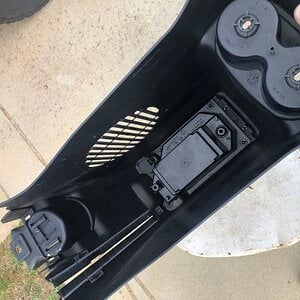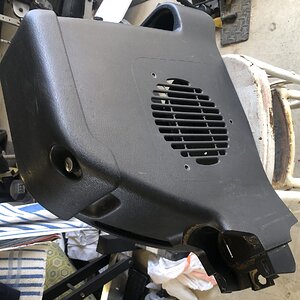lotas 10+ year member
CarAudio.com Elite
There seems to be a lot of questions regarding fuses and fuse sizes lately.
Here are some helpful hints in the process to find the right fuse for you.
1.) Determine your wire size's max. amp capacity. Refer to http://www.the12volt.com/info/recwirsz.asp to find your wire. A lot of people run 1/0 so we will use this as an example. The max capacity is 350amps. This means that if more than 350amps are running through the wire it will burn. The point of a fuse is to have the fuse open before this wire burns.
2.) Next, you have to understand the point of the fuse as explained earlier, so obviously you want to make sure the fuse is not larger than the max. capacity of the wire, as we want the fuse to open (or blow/break are other terms) before the wire burns. So right now we are looking at fuses under 350amps.
*By the way... When you are dealing with a fuse size up around 300amps or so, you will probably be looking at ANL fuses (the long ones horizontally, with a sort of spade terminal on each end), not AGU (the cylinder ones) or MAXI (the colored plastic ones found in you car/truck fuse box). *
3.) Next we have to make sure that your equipment will not draw too many amps to open the fuse. **IF YOU DO NOT HAVE A HIGH WATTAGE SYSTEM YOU CAN SKIP OVER STEP 3** For this step, we have some calculations to do. Let's say for arguements sake we are running a 1500watt Class D mono amp for our subwoofer, and a 300watt Class A/B amp for our components. To calculate the estimated amps that each of these will require, here is a quick calculation.
A.) Take each amp, one at a time, and take the amps RMS and (too be safe) divide by 12. (More realistically, your car runs at about 13.8volts, but to be safe, use 12. You could calculate for 12volts and 13.8 and average the two, but we are just looking for a ballpark figure).
1500(watts rms)/12(volts) = 125amperes (or amps) current
300(watts rms)/12(volts) = 25 amperes (or amps) current
B.) Next you want to account for class efficiency. Class D amps are about 80% efficient, so take your figure from your class D amp, 125amps, and multiply it by .2 (or 20%) to add efficiency.
125amps * .2 (class D efficiency) = 25amps
Now add this figure to the original
125amps(from the total RMS/12 of the class D amp) + 25amps (the class D efficiency) which gives you 150amps. So your 1500watt class D amp will draw around 150amps. Already you can see what could go wrong if you used a 150amp fuse, for just this amp alone is drawing around 150amps, which could open our fuse.
Now for the 300watt A/B amp. A/B amps are about 60% efficient, so multiply the original figure by .4 (40%)
25amps * .4 (class A/B efficiency) = 10amps
As we did with the Class D, add 25amps (total RMS/12 from the A/B amp) and add the 10amp (Class A/B efficiency) = 35amps
C. This gives you 150amps for you Class D amp, and 35amps for your A/B amp. Therefore your system will pull around 185amps, at full RMS, at 12volts (although when your alternator is running, you are at more around 13.8volts, which would give us a smaller figure than 185, more around 150 or so)
4.) So as we know our fuse must be rated ABOVE what our system will draw, we now know approximately what our system WILL draw, which is 185amps. Therefore our fuse must be under 350amps, and over 185amps. A 200amp or 250amp fuse would be fine for this situation, most people go with a 250amp fuse on 1/0gauge.
I am no electrical engineer, so please, feel free to chime in on anything you feel is wrong and should be corrected, or any questions. I will gladly edit and make changes. Thanks for your time, I hope this can help a few people out.
Here are some helpful hints in the process to find the right fuse for you.
1.) Determine your wire size's max. amp capacity. Refer to http://www.the12volt.com/info/recwirsz.asp to find your wire. A lot of people run 1/0 so we will use this as an example. The max capacity is 350amps. This means that if more than 350amps are running through the wire it will burn. The point of a fuse is to have the fuse open before this wire burns.
2.) Next, you have to understand the point of the fuse as explained earlier, so obviously you want to make sure the fuse is not larger than the max. capacity of the wire, as we want the fuse to open (or blow/break are other terms) before the wire burns. So right now we are looking at fuses under 350amps.
*By the way... When you are dealing with a fuse size up around 300amps or so, you will probably be looking at ANL fuses (the long ones horizontally, with a sort of spade terminal on each end), not AGU (the cylinder ones) or MAXI (the colored plastic ones found in you car/truck fuse box). *
3.) Next we have to make sure that your equipment will not draw too many amps to open the fuse. **IF YOU DO NOT HAVE A HIGH WATTAGE SYSTEM YOU CAN SKIP OVER STEP 3** For this step, we have some calculations to do. Let's say for arguements sake we are running a 1500watt Class D mono amp for our subwoofer, and a 300watt Class A/B amp for our components. To calculate the estimated amps that each of these will require, here is a quick calculation.
A.) Take each amp, one at a time, and take the amps RMS and (too be safe) divide by 12. (More realistically, your car runs at about 13.8volts, but to be safe, use 12. You could calculate for 12volts and 13.8 and average the two, but we are just looking for a ballpark figure).
1500(watts rms)/12(volts) = 125amperes (or amps) current
300(watts rms)/12(volts) = 25 amperes (or amps) current
B.) Next you want to account for class efficiency. Class D amps are about 80% efficient, so take your figure from your class D amp, 125amps, and multiply it by .2 (or 20%) to add efficiency.
125amps * .2 (class D efficiency) = 25amps
Now add this figure to the original
125amps(from the total RMS/12 of the class D amp) + 25amps (the class D efficiency) which gives you 150amps. So your 1500watt class D amp will draw around 150amps. Already you can see what could go wrong if you used a 150amp fuse, for just this amp alone is drawing around 150amps, which could open our fuse.
Now for the 300watt A/B amp. A/B amps are about 60% efficient, so multiply the original figure by .4 (40%)
25amps * .4 (class A/B efficiency) = 10amps
As we did with the Class D, add 25amps (total RMS/12 from the A/B amp) and add the 10amp (Class A/B efficiency) = 35amps
C. This gives you 150amps for you Class D amp, and 35amps for your A/B amp. Therefore your system will pull around 185amps, at full RMS, at 12volts (although when your alternator is running, you are at more around 13.8volts, which would give us a smaller figure than 185, more around 150 or so)
4.) So as we know our fuse must be rated ABOVE what our system will draw, we now know approximately what our system WILL draw, which is 185amps. Therefore our fuse must be under 350amps, and over 185amps. A 200amp or 250amp fuse would be fine for this situation, most people go with a 250amp fuse on 1/0gauge.
I am no electrical engineer, so please, feel free to chime in on anything you feel is wrong and should be corrected, or any questions. I will gladly edit and make changes. Thanks for your time, I hope this can help a few people out.


